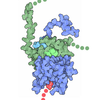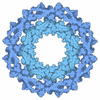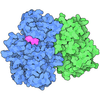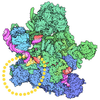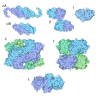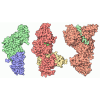+ Open data
Open data
- Basic information
Basic information
| Entry | Database: PDB / ID: 5zcs | |||||||||||||||
|---|---|---|---|---|---|---|---|---|---|---|---|---|---|---|---|---|
| Title | 4.9 Angstrom Cryo-EM structure of human mTOR complex 2 | |||||||||||||||
 Components Components |
| |||||||||||||||
 Keywords Keywords | GENE REGULATION / Cryo-EM structure human mTORC2 | |||||||||||||||
| Function / homology |  Function and homology information Function and homology informationRNA polymerase III type 2 promoter sequence-specific DNA binding / RNA polymerase III type 1 promoter sequence-specific DNA binding / positive regulation of cytoplasmic translational initiation / regulation of locomotor rhythm / T-helper 1 cell lineage commitment / positive regulation of pentose-phosphate shunt / positive regulation of wound healing, spreading of epidermal cells / regulation of phosphatidylinositol 3-kinase/protein kinase B signal transduction / TORC2 signaling / TORC2 complex ...RNA polymerase III type 2 promoter sequence-specific DNA binding / RNA polymerase III type 1 promoter sequence-specific DNA binding / positive regulation of cytoplasmic translational initiation / regulation of locomotor rhythm / T-helper 1 cell lineage commitment / positive regulation of pentose-phosphate shunt / positive regulation of wound healing, spreading of epidermal cells / regulation of phosphatidylinositol 3-kinase/protein kinase B signal transduction / TORC2 signaling / TORC2 complex / regulation of membrane permeability / cellular response to leucine starvation / negative regulation of lysosome organization / heart valve morphogenesis / TFIIIC-class transcription factor complex binding / TORC1 complex / voluntary musculoskeletal movement / positive regulation of transcription of nucleolar large rRNA by RNA polymerase I / regulation of cellular response to oxidative stress / calcineurin-NFAT signaling cascade / RNA polymerase III type 3 promoter sequence-specific DNA binding / positive regulation of keratinocyte migration / regulation of osteoclast differentiation / regulation of lysosome organization / MTOR signalling / cellular response to L-leucine / energy reserve metabolic process / regulation of autophagosome assembly / Energy dependent regulation of mTOR by LKB1-AMPK / cellular response to nutrient / phosphatidic acid binding / Amino acids regulate mTORC1 / TORC1 signaling / negative regulation of Ras protein signal transduction / serine/threonine protein kinase complex / embryo development ending in birth or egg hatching / ruffle organization / cellular response to methionine / phosphatidylinositol-3,4-bisphosphate binding / negative regulation of cell size / positive regulation of ubiquitin-dependent protein catabolic process / cellular response to osmotic stress / phosphatidylinositol-3,5-bisphosphate binding / negative regulation of protein localization to nucleus / anoikis / inositol hexakisphosphate binding / cardiac muscle cell development / negative regulation of calcineurin-NFAT signaling cascade / regulation of myelination / positive regulation of transcription by RNA polymerase III / regulation of establishment of cell polarity / negative regulation of macroautophagy / Macroautophagy / lipid biosynthetic process / positive regulation of myotube differentiation / regulation of cell size / Constitutive Signaling by AKT1 E17K in Cancer / positive regulation of actin filament polymerization / germ cell development / phosphatidylinositol-3,4,5-trisphosphate binding / behavioral response to pain / TOR signaling / oligodendrocyte differentiation / positive regulation of oligodendrocyte differentiation / mTORC1-mediated signalling / positive regulation of translational initiation / CD28 dependent PI3K/Akt signaling / HSF1-dependent transactivation / regulation of macroautophagy / positive regulation of TOR signaling / enzyme-substrate adaptor activity / response to amino acid / 'de novo' pyrimidine nucleobase biosynthetic process / positive regulation of epithelial to mesenchymal transition / vascular endothelial cell response to laminar fluid shear stress / positive regulation of lipid biosynthetic process / heart morphogenesis / cellular response to nutrient levels / neuronal action potential / regulation of cellular response to heat / positive regulation of lamellipodium assembly / cardiac muscle contraction / T cell costimulation / positive regulation of stress fiber assembly / phagocytic vesicle / positive regulation of endothelial cell proliferation / phosphatidylinositol-4,5-bisphosphate binding / endomembrane system / cytoskeleton organization / substantia nigra development / negative regulation of insulin receptor signaling pathway / negative regulation of autophagy / cellular response to amino acid starvation / regulation of signal transduction by p53 class mediator / positive regulation of glycolytic process / cellular response to starvation / positive regulation of translation / protein serine/threonine kinase activator activity / Regulation of PTEN gene transcription / VEGFR2 mediated vascular permeability Similarity search - Function | |||||||||||||||
| Biological species |  Homo sapiens (human) Homo sapiens (human) | |||||||||||||||
| Method | ELECTRON MICROSCOPY / single particle reconstruction / cryo EM / Resolution: 4.9 Å | |||||||||||||||
 Authors Authors | Chen, X. / Liu, M. / Tian, Y. / Wang, H. / Wang, J. / Xu, Y. | |||||||||||||||
| Funding support |  China, 4items China, 4items
| |||||||||||||||
 Citation Citation |  Journal: Cell Res / Year: 2018 Journal: Cell Res / Year: 2018Title: Cryo-EM structure of human mTOR complex 2. Authors: Xizi Chen / Mengjie Liu / Yuan Tian / Jiabei Li / Yilun Qi / Dan Zhao / Zihan Wu / Min Huang / Catherine C L Wong / Hong-Wei Wang / Jiawei Wang / Huirong Yang / Yanhui Xu /  Abstract: Mechanistic target of rapamycin (mTOR) complex 2 (mTORC2) plays an essential role in regulating cell proliferation through phosphorylating AGC protein kinase family members, including AKT, PKC and ...Mechanistic target of rapamycin (mTOR) complex 2 (mTORC2) plays an essential role in regulating cell proliferation through phosphorylating AGC protein kinase family members, including AKT, PKC and SGK1. The functional core complex consists of mTOR, mLST8, and two mTORC2-specific components, Rictor and mSin1. Here we investigated the intermolecular interactions within mTORC2 complex and determined its cryo-electron microscopy structure at 4.9 Å resolution. The structure reveals a hollow rhombohedral fold with a 2-fold symmetry. The dimerized mTOR serves as a scaffold for the complex assembly. The N-terminal half of Rictor is composed of helical repeat clusters and binds to mTOR through multiple contacts. mSin1 is located close to the FRB domain and catalytic cavity of mTOR. Rictor and mSin1 together generate steric hindrance to inhibit binding of FKBP12-rapamycin to mTOR, revealing the mechanism for rapamycin insensitivity of mTORC2. The mTOR dimer in mTORC2 shows more compact conformation than that of mTORC1 (rapamycin sensitive), which might result from the interaction between mTOR and Rictor-mSin1. Structural comparison shows that binding of Rictor and Raptor (mTORC1-specific component) to mTOR is mutually exclusive. Our study provides a basis for understanding the assembly of mTORC2 and a framework to further characterize the regulatory mechanism of mTORC2 pathway. | |||||||||||||||
| History |
|
- Structure visualization
Structure visualization
| Movie |
 Movie viewer Movie viewer |
|---|---|
| Structure viewer | Molecule:  Molmil Molmil Jmol/JSmol Jmol/JSmol |
- Downloads & links
Downloads & links
- Download
Download
| PDBx/mmCIF format |  5zcs.cif.gz 5zcs.cif.gz | 1.1 MB | Display |  PDBx/mmCIF format PDBx/mmCIF format |
|---|---|---|---|---|
| PDB format |  pdb5zcs.ent.gz pdb5zcs.ent.gz | 906.2 KB | Display |  PDB format PDB format |
| PDBx/mmJSON format |  5zcs.json.gz 5zcs.json.gz | Tree view |  PDBx/mmJSON format PDBx/mmJSON format | |
| Others |  Other downloads Other downloads |
-Validation report
| Summary document |  5zcs_validation.pdf.gz 5zcs_validation.pdf.gz | 830.6 KB | Display |  wwPDB validaton report wwPDB validaton report |
|---|---|---|---|---|
| Full document |  5zcs_full_validation.pdf.gz 5zcs_full_validation.pdf.gz | 858.4 KB | Display | |
| Data in XML |  5zcs_validation.xml.gz 5zcs_validation.xml.gz | 148.2 KB | Display | |
| Data in CIF |  5zcs_validation.cif.gz 5zcs_validation.cif.gz | 234.6 KB | Display | |
| Arichive directory |  https://data.pdbj.org/pub/pdb/validation_reports/zc/5zcs https://data.pdbj.org/pub/pdb/validation_reports/zc/5zcs ftp://data.pdbj.org/pub/pdb/validation_reports/zc/5zcs ftp://data.pdbj.org/pub/pdb/validation_reports/zc/5zcs | HTTPS FTP |
-Related structure data
| Related structure data | 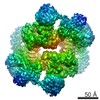 6913MC M: map data used to model this data C: citing same article ( |
|---|---|
| Similar structure data |
- Links
Links
- Assembly
Assembly
| Deposited unit | 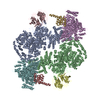
|
|---|---|
| 1 |
|
- Components
Components
| #1: Protein | Mass: 289257.969 Da / Num. of mol.: 2 Source method: isolated from a genetically manipulated source Source: (gene. exp.)  Homo sapiens (human) / Gene: MTOR, FRAP, FRAP1, FRAP2, RAFT1, RAPT1 / Cell line (production host): 293F / Production host: Homo sapiens (human) / Gene: MTOR, FRAP, FRAP1, FRAP2, RAFT1, RAPT1 / Cell line (production host): 293F / Production host:  Homo sapiens (human) Homo sapiens (human)References: UniProt: P42345, non-specific serine/threonine protein kinase #2: Protein | Mass: 35910.090 Da / Num. of mol.: 2 Source method: isolated from a genetically manipulated source Source: (gene. exp.)  Homo sapiens (human) / Gene: MLST8, GBL, LST8 / Cell line (production host): 293F / Production host: Homo sapiens (human) / Gene: MLST8, GBL, LST8 / Cell line (production host): 293F / Production host:  Homo sapiens (human) / References: UniProt: Q9BVC4 Homo sapiens (human) / References: UniProt: Q9BVC4#3: Protein | Mass: 175142.500 Da / Num. of mol.: 2 Source method: isolated from a genetically manipulated source Source: (gene. exp.)  Homo sapiens (human) / Gene: RICTOR, KIAA1999 / Cell line (production host): 293F / Production host: Homo sapiens (human) / Gene: RICTOR, KIAA1999 / Cell line (production host): 293F / Production host:  Homo sapiens (human) / References: UniProt: Q6R327 Homo sapiens (human) / References: UniProt: Q6R327#4: Protein | Mass: 55158.477 Da / Num. of mol.: 2 Source method: isolated from a genetically manipulated source Source: (gene. exp.)  Homo sapiens (human) / Gene: MAPKAP1, MIP1, SIN1 / Cell line (production host): 293F / Production host: Homo sapiens (human) / Gene: MAPKAP1, MIP1, SIN1 / Cell line (production host): 293F / Production host:  Homo sapiens (human) / References: UniProt: Q9BPZ7 Homo sapiens (human) / References: UniProt: Q9BPZ7Sequence details | 1. FOR ENTITY 3 (CHAINS E/F), ENTIRE SEQUENCE HAS BEEN USED IN THE EXPERIMENT. HOWEVER, C-TERMINAL ...1. FOR ENTITY 3 (CHAINS E/F), ENTIRE SEQUENCE HAS BEEN USED IN THE EXPERIMENT | |
|---|
-Experimental details
-Experiment
| Experiment | Method: ELECTRON MICROSCOPY |
|---|---|
| EM experiment | Aggregation state: PARTICLE / 3D reconstruction method: single particle reconstruction |
- Sample preparation
Sample preparation
| Component | Name: human mTOR Complex 2 / Type: COMPLEX / Entity ID: all / Source: RECOMBINANT |
|---|---|
| Molecular weight | Value: 1400 kDa/nm / Experimental value: YES |
| Source (natural) | Organism:  Homo sapiens (human) Homo sapiens (human) |
| Source (recombinant) | Organism:  Homo sapiens (human) / Cell: 293F Homo sapiens (human) / Cell: 293F |
| Buffer solution | pH: 7.4 |
| Specimen | Conc.: 1.5 mg/ml / Embedding applied: NO / Shadowing applied: NO / Staining applied: NO / Vitrification applied: YES |
| Specimen support | Grid material: GOLD / Grid mesh size: 300 divisions/in. / Grid type: Quantifoil R1.2/1.3 |
| Vitrification | Instrument: FEI VITROBOT MARK IV / Cryogen name: ETHANE / Humidity: 100 % / Chamber temperature: 282 K |
- Electron microscopy imaging
Electron microscopy imaging
| Experimental equipment |  Model: Titan Krios / Image courtesy: FEI Company |
|---|---|
| Microscopy | Model: FEI TITAN KRIOS |
| Electron gun | Electron source:  FIELD EMISSION GUN / Accelerating voltage: 300 kV / Illumination mode: FLOOD BEAM FIELD EMISSION GUN / Accelerating voltage: 300 kV / Illumination mode: FLOOD BEAM |
| Electron lens | Mode: BRIGHT FIELD / Cs: 2.7 mm / C2 aperture diameter: 100 µm |
| Specimen holder | Cryogen: NITROGEN / Specimen holder model: FEI TITAN KRIOS AUTOGRID HOLDER |
| Image recording | Average exposure time: 8 sec. / Electron dose: 50 e/Å2 / Detector mode: COUNTING / Film or detector model: GATAN K2 SUMMIT (4k x 4k) |
| Image scans | Movie frames/image: 32 / Used frames/image: 1-32 |
- Processing
Processing
| Software | Name: PHENIX / Version: 1.13_2998: / Classification: refinement | ||||||||||||||||||||||||||||
|---|---|---|---|---|---|---|---|---|---|---|---|---|---|---|---|---|---|---|---|---|---|---|---|---|---|---|---|---|---|
| EM software |
| ||||||||||||||||||||||||||||
| CTF correction | Type: NONE | ||||||||||||||||||||||||||||
| Symmetry | Point symmetry: C2 (2 fold cyclic) | ||||||||||||||||||||||||||||
| 3D reconstruction | Resolution: 4.9 Å / Resolution method: FSC 0.143 CUT-OFF / Num. of particles: 195353 / Symmetry type: POINT | ||||||||||||||||||||||||||||
| Atomic model building | Protocol: OTHER / Space: REAL | ||||||||||||||||||||||||||||
| Refine LS restraints |
|
 Movie
Movie Controller
Controller



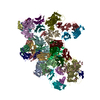




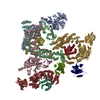


 PDBj
PDBj